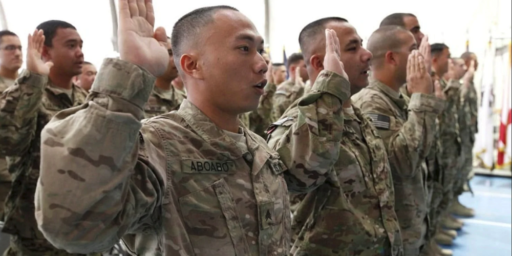Mathematics of Troop Strength
An editorial in today’s New York Times expresses relief that the Bush administration is finally acknowledging the need to increase the size of the Army and Marine Corps:
Larger ground forces are an absolute necessity for the sort of battles America is likely to fight during the coming decades: extended clashes with ground-based insurgents rather than high-tech shootouts with rival superpowers. The president’s belated recognition is welcome, though it comes only after significant damage has been done to the Army’s morale, recruitment standards and fighting readiness. Given the time required to recruit and train the additional troops, the proposed increase will not make much difference in Iraq’s current battles. But over time it will help make America more secure and better prepared to meet future crises.
Now, I agree that it is indeed too late to expand the force in time for it to matter in Iraq, unless we’re actually committed to our mission and willing to spend several more years there. Then again, that was true in September 2001, let alone March 2003, as well.
One wonders, though, how the NYT thinks that expanding the size of the force earlier would have allowed us to maintain pre-war recruiting standards? If we had to lower standards to get people to volunteer for service during wartime–and we did, once the patriotic fervor of 9/11 wore off–then it is axiomatic that we would have had to lower them even further to recruit another 30,000 troops. Or, conversely, we could have raised enlistment/re-enlistment bonuses more. Regardless, it’s much harder to recruit X+30,000 troops than X troops.
The central premise of the editorial–that we must adjust troop strength requirements to match the strategic environment–is quite right, of course. The difficulty, though, is anticipating those requirements years in advance. Historically, we have done a very poor job of that, with the exception of the prolonged Cold War period when the situation was essentially static for decades.
With respect to the present situation, it is unreasonable to have expected the Clinton administration to have anticipated the needs of a prolonged counterinsurgency effort in Iraq. And, given that the Bush administration honestly believed the war in Iraq necessary–regardless of how well founded that may have been–it was not unreasonable to think they could do it with the available force. Yes, there were many experts, notably then-Army Chief of Staff Eric Shinseki, who argued we needed a larger post-invasion force than we used. On the other hand, the Joint Staff usually plans for a much-larger-than-needed contingent (see Desert Storm, for example) and the operational commander, Tommy Franks, preferred a faster, leaner force. Further, there is an ongoing debate among the experts about the required troop strength, given that more troops equals more targets and more resentment.
The military establishment and the last two administrations genuinely do deserve criticism for the fact that the force is still way too short on Arab linguists, those with training in Middle East cultures, civil affairs personnel, Special Forces trainers, and other specialists needed for COIN and stabilization operations. Given that “9/11 changed everything,” it was especially incumbent on the current administration and military leadership to address those needs. That there has barely been a start toward that end–in the military, intelligence community, FBI, and elsewhere–is true malfeasance.



